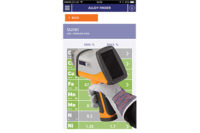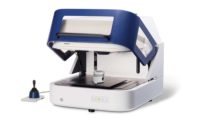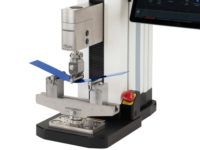NDT - XRF Analyzers
Minimize Global Supply Chain Risks through Material Inspection
X-ray fluorescence (XRF) analysis simplifies quality assurance inspections for complex global supply chains.

Handheld X-Ray Fluorescence (XRF) for material identification prior to installation is shown here. Source: Oxford Instruments

This is a laboratory X-Ray Fluorescence (XRF) analyzer for RoHS and compliance testing. Source: Oxford Instruments

A handheld X-Ray Fluorescence (XRF) analyzer for quality control can help improve confidence in a quality system. Source: Oxford Instruments



There are many complexities in today’s global supply chain and taking reasonable steps to perform due diligence by minimizing risks through accurate material identification should be high on the list of priorities for both suppliers and manufacturers. Suppliers are expected to have in-depth knowledge of the manufacturing processes used to produce the materials they supply; however, it is ultimately the responsibility of the producer to ensure compliance of all materials used in a finished product prior to its landing on the shelf. Quality recalls are costly and companies cannot jeopardize having downtime resulting from batch contamination and other risks involved in incorporating non-compliant raw materials and bogus subassemblies into their manufacturing process. Moreover, the distribution of unsafe products into the marketplace can cause a business irreparable and economic harm along with potential for human fatality.
Modern manufacturers need to comply with numerous safety standards and specifications established by several organizations including the Occupational Safety and Health Administration (OSHA), the American Petroleum Institute (API) 578 and 571 regulations, International Organization for Standardization (ISO), American National Standards Institute (ANSI) and American Society for Testing and Materials (ASTM), Good Manufacturing Practices (GMP) and the Environmental Protection Agency (EPA) to name a few.
Nondestructive testing using X-ray fluorescence (XRF) can help manufacturers to accurately authenticate purchases and ensure that products introduced into the manufacturing process are compliant to local standards. XRF analysis includes no, or minimal, sample preparation, along with accurate measurements of solids, liquids and powdered samples. XRF technology has traditionally and most commonly been used in quality control for metal alloys and Flow Accelerated Corrosion (FAC) inspection but its uses can extend well beyond Positive Materials Identification (PMI). The XRF technique is versatile enough that it can be carried out in-situ, on the manufacturing floor, or at incoming inspection for a wide variety of applications.
If you are involved in a quality assurance role within your company then you are familiar with the importance of having in-depth knowledge about all the materials being used in the manufacturing process. Likewise, there are good reasons to ensure that materials from your global supply chains are accurately identified prior to introducing them into your company’s manufacturing process. For one, global suppliers may not be the actual manufacturer of the materials they are supplying. This makes it increasingly difficult for manufacturing companies to have complete transparency into all of the products being used in their assembly lines. In addition, within a global supply chain it is not uncommon for quality specifications to literally “get lost in translation.”
Inconsistencies in quality simply may be a result of language barriers where it becomes difficult to communicate specifications and to fully understand where breakdowns in specifications resulted in a product’s poor quality. Plus, variations in quality requirements from around the world can further result in a lack of understanding of exact quality specifications from country to country. Some companies choose to rely on material test reports supplied with their purchases. This can lead to dangerous situations where the test reports were attached to the wrong shipment, or where the testing was limited to a set list of expected elements, potentially ignoring other constituents that may be hazardous or lead to manufacturing defects.
Commonly, PMI testing is used to identify what metal alloys you are receiving, installing, storing in a warehouse or are currently installed. Simply knowing the difference between 304, 316 and 321 stainless steel through testing can ensure you are getting what you are paying for and using the right material for the job. However, while a specific material may meet an overall alloy grade specification, other residual elements may be present that could lead to mechanical failures like premature wear or corrosion, cross contamination, poor welding or even present end of life disposal problems if these elements appear on any banned lists. If you are not using XRF technology or do not have the ability to determine whether these unknowns are present, you can potentially be introducing long-term problems for your company.
Incoming Inspection, RoHS Compliance and Improved Supply Chain Efficiencies
Adoption of worldwide regulations for Restriction of Hazardous Substances (RoHS), Directive 2011/65/EU, End of Life Vehicle (ELV) programs, California Proposition 65, and Consumer Product Safety Commission (CPSC) guidelines have a direct influence on global manufacturing and supply chain management. RoHS compliance directly affects a countless number of products worldwide. If your company is involved in the sale, manufacturing or the import or export of electronic equipment parts you are likely subject to RoHS compliance. RoHS compliance means that manufacturers and suppliers are acting in full accordance with RoHS regulations and are documenting the testing. Manufacturers using XRF technology can directly test for the presence of Lead (Pb), Mercury (Hg), and Cadmium (Cd), as well as, screen for the presence of hexavalent Chromium (Cr (VI)) by measuring total Chromium (Cr) content, and the presence of Polybrominated Biphenyls (PBB) and Polybrominated Diphenyl Ethers (PBDE) by measuring total Bromine (Br) content.
Failure to make products that are RoHS compliant or simply not being able to produce adequate documentation for validation of compliance can result in heavy fines and penalties or potentially get your company listed on a banned supplier list. Specific penalties related to RoHS compliance can vary greatly by region, country or state, and in some cases, businesses can even be denied import of their products.
The presence of toxic materials is not limited solely to industrial equipment. Sadly, hazardous elements and compounds are discovered in products intended for children, where ingestion could cause developmental disorders. The U.S. Consumer Product Safety Commission (CPSC) is tasked with protecting the public against unreasonable risks of injury or death from consumer products through education, safety standards activities, regulation and enforcement. The CPSC requires all manufacturers and importers of children’s products to certify their products comply with mandatory rules after testing at third party laboratories whose accreditation is accepted by the CPSC. In 2008, the CPSC introduced the Consumer Products Safety Improvement Act (CPSIA), which reduced the permissible content of eight heavy metals in children’s products. The CPSIA includes testing protocols from ASTM International’s test method F963-11.
While confirmatory testing is performed through destructive laboratory techniques, XRF is used as part of a reasonable screening program since it is a quick, easy and nondestructive way to increase the number of samples that can be measured from a given batch, thereby increasing the odds of discovering products that should not be introduced to the public. Despite increased legislation and regulation, many global suppliers continue to find that unacceptable levels of these elements can still be found in children’s products.
Authenticate What is Being Purchased and Avoid Being Victim to Counterfeit Components
In recent years, there has been an influx in the number of misrepresented components being introduced into the electronic supply chain causing increased concern for quality inspectors. These counterfeit components can be acquired in many ways. Sometimes they are parts that have been discontinued, or parts that have been deemed obsolete based on expected shelf life, but these parts continue to be distributed by brokers, or perhaps in assemblies, or are derived from older recycled devices which are falsely being introduced into the supply chain as new. These components are often made available to the supplier or manufacturer at a lowered cost.
As a result, manufacturers are now challenged with accurately identifying and detecting counterfeit electronic components and assemblies to ensure that these counterfeit components do not enter their production process. Counterfeit components pose a real danger when incorporated into products newly introduced in the marketplace because they can cause catastrophic failure, resulting in harm or even death. The counterfeiter’s sophistication has also grown, making visual inspection insufficient to determine previous use or possible refinishing. In the growing concern of a “lead free” world there is now increased concern of counterfeit RoHS representation. XRF inspection is often able to reveal hidden features that the naked eye cannot.
In addition, military and high reliability electronics sectors are exempt from “Pb free” due to lack of long term testing history (that has been underway but not yet completed) to prove that Pb-free components can withstand the harsher environments. These components are typically used in defense, space exploration, aerospace and data storage/processing servers exposed to high levels of vibration, pressurization/depressurization and extreme temperature variations along with long term heat exposure. Here suppliers need to maintain segregated manufacturing and storage cells for Pb-containing and Pb-free items for their varied customer base. This presents a risk of cross contamination or product mix-ups in the supply chain. XRF allows these industries to perform a rapid, nondestructive screening of these mission-critical components to help ensure the final assemblies perform reliably as expected.
Due to the ever changing demands placed on manufacturing by new legislations, recycling and global supply chains, it is imperative to have a due diligence program in place to screen for potential hidden problems. Both portable and benchtop XRF systems offer unique benefits and are a great tool to aid in protecting your organization from these potential risks at reasonable investment levels. Having this capability within your organization can eliminate high, accumulating costs of sending samples out for laboratory analysis, and having to wait long periods of time, sometimes weeks, for results needed to make key decisions. Screening components using the XRF technique will instill a higher level of confidence with your customers regarding your quality system, improve process efficiencies, and allow your organization to avoid problematic or high risk suppliers.
Looking for a reprint of this article?
From high-res PDFs to custom plaques, order your copy today!








